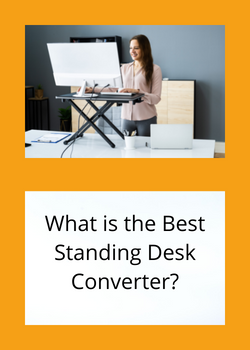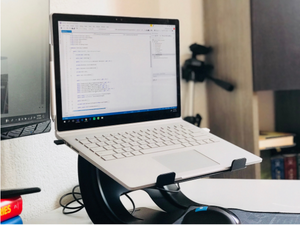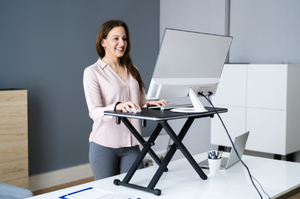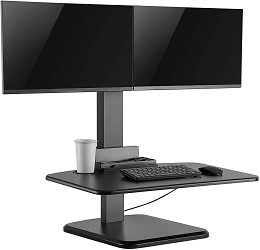 To choose the best standing desk converter, you need to know what types are out there and what their key features are.
To choose the best standing desk converter, you need to know what types are out there and what their key features are.
It’s also a good idea to determine which features are important to you, so you can make the perfect pairing for your ideal office set up.
We’ve given you a run-down on the most popular types and styles below, along with their pros and cons to help you decide which option will work best for you.
If you’re buying a standing desk converter – especially for the first time – take a look at the key points to consider before making your final choice as well.
Table of Contents
Types of Standing Desk Converter
Key Points – Read Before You Buy
Including measuring up, weight, height range and adjustment type.
Types of Standing Desk Converter
Basic Laptop Stands
 If you’re limited for space and work with minimal equipment – i.e. a laptop only – then the basic laptop stand can be a great solution whilst being kind to your wallet.
If you’re limited for space and work with minimal equipment – i.e. a laptop only – then the basic laptop stand can be a great solution whilst being kind to your wallet.
They take up very little room and are usually extremely light. Some are collapsible with a handle for portability – easy to take with you from home to office and back again.
By their very nature, they offer little way in the way of space and are designed to support just a few kilos. They also have a limited height range, making them unsuitable for taller or even average height users.
Also, don’t be swayed by the tilt. An upward tilt – such as the one pictured – can actually put additional strain on your hands and wrists.
Sure, these are OK for the very short term or occasional use, but if you’re planning on using your laptop stand more often, go for a riser without the tilt (see also single tier converters) or choose a model with a negative – or downward – tilt. For standing work, around 20° is recommended for more natural and neutral positioning.
PROs – low on price, great for portability, ideal for compact work stations.
CONs – limited workspace, low weight capacity, limited height range.
Single Tier Converters

A single tier riser can give you more space than the basic laptop stand. Sizes vary, with larger versions measuring up to around 80cm in width.
Usually they have an x-frame design (as pictured) and adjust manually. Most models have fixed height settings – some with only 2 or 3 height options, others with 10 or more.
Lightweight models can provide a portable solution if you’re flitting between home and office.
Generally these types of converter are another good budget option, but you’ll also find that the weight capacity is on the low side. Do your homework before you buy and choose a good, sturdy model to avoid excessive wobble.
PROs – low on price, good for compact spaces, lightweight versions are good for portability.
CONs – usually limited to pre-set heights, can be low on workspace, low weight capacity.
Dual Tier Converters

With dual tier converters you have 2 levels to work from. Usually the lower level is designed to support your keyboard and mouse, with the upper shelf supporting one or more monitors.
Super sturdy designs can also handle monitor mounts, freeing up that valuable desktop space.
Designs differ and some feature a cut-out on the upper level so you have space to place your laptop on the lower tier. Others lose some workspace on the lower tier to allow for adjustment, so check that your keyboard and mouse will fit.
Whatever your set up, as well as checking the design and dimensions on both tiers, be sure to check the weight capacity.
You can choose manual or electric adjustment and either an x- or z-frame design. X-frames feature straightforward up and down adjustment. Z-frames adjust up and out or down and back, so you’ll need to allow for some extra depth when measuring up.
PROs – good choice of size, design and adjustment method.
CONs – may lose some workspace due to cut-outs and recesses, z-frame designs require additional space for depth.
Post and Base Risers

Post and base styles generally feature a single tier to work from which is attached to a post at the rear. Above this you’ll find a mount for single or multiple monitors. (Usually with a VESA plate.)
These compact workstations tend to have a small footprint and are particularly geared towards those requiring less in desktop and more in visuals.
Independent adjustment between worktop and monitors makes for superior ergonomic screen positioning, as does the rotation and tilt function of the mounts.
Adjustment may be manual or electric and these style converters can be a good choice for taller users. Be sure to check weight capacity as this tends towards the lower end of the scale.
PROs – small footprint, multiple monitor set-up options, great ergonomic screen positioning.
CONs – minimal desktop space, lower weight capacity.
Hovering Converters

These types are similar to post and base converters in that they usually feature a single tier to work from, above which is a (VESA) monitor mount.
The hovering converter, however, has a small attaching mount for the desk or wall, giving it a minimal to zero footprint.
The connecting arm is height adjustable and extendable, making it easy to screen share with co-workers. It can also be folded away when out of use, or if you need to switch quickly between standing and seated desk work.
A great solution if you’re really limited for space, but generally low on weight capacity. Also, be sure to attach the unit properly when installing.
PROs – minimal to zero footprint, great for screen sharing, alternate quickly between standing and sitting.
CONs – limited desktop space, lower weight capacity.
Key Points – Read Before You Buy
Measuring Up
Take actual measurements when choosing your desk converter. Firstly to make sure your gear will fit. (Don’t just rely on advertising images – these can be misleading.) And secondly to make sure your chosen model will fit into your workspace. In particular check the footprint and allow for an overhang if you choose a z-frame riser.
Weight Capacity
 Of course, you need to know that your chosen converter can lift your equipment. Stick within the weight recommendations to keep your gear safe, to keep your riser rising and to avoid voiding the converter warranty.
Of course, you need to know that your chosen converter can lift your equipment. Stick within the weight recommendations to keep your gear safe, to keep your riser rising and to avoid voiding the converter warranty.
You’ll also need to be sure that your supporting desk can handle the weight of your kit and converter combined; factor them both in when checking your desk capacity.
Height Range
We use Inch Calculator for recommended sitting and standing desk heights. When working out the height required for your chosen desk converter, measure up your supporting desk first and work from there.
You’ll also find guidelines for monitor and chair height. These are great as guidelines but take your own measurements for optimum ergonomic set-up.
Type of Adjustment
Perhaps the most important decision when it comes to a desk converter is whether to opt for manual or electric adjustment.
If you go manual, you’ll probably be limited by pre-set heights. You’ll also need to make a little more effort than you would with electric adjustment. On the plus side, these converters generally work out cheapest of all.
Alternatively, go electric. Controllers are either simple 2-button affairs for up and down, or they come with a memory height function. Extra features include anti-collision technology, overheat protection and sit stand reminders.
Top end electric converters can be at the upper end of the price scale. But if you look around, you’ll find some great deals from well-known brands. The longer the warranty the better, especially when it comes to motor cover.
The Best Standing Desk Converter Takeaway
To choose the best standing desk converter for you, it’s important to have a good understanding of what options are out there and how they function for different workstation set-ups.
Next, take a look at how you work and what you need from a converter in order to gain the most in terms of ergonomics.
Whichever style or type you choose, be sure to take into consideration the key factors such as size, weight, height and adjustment type. This way you should be able to make the perfect pairing first time, saving your valuable time and money.
Alternating between sitting and standing throughout the day is a great way to improve your health and productivity. Ease into it gently to give your body chance to get used to the new routine. If you can, split your time 50 / 50, swapping from sitting to standing every 30 minutes.
We’d love to hear from you with questions or feedback, so drop a comment in the box below or email jane@standingdeskuk.com.
If you’re not sure about desk converters, maybe you’re ready for a standing desk instead. Take a look at our recommendations for Best Electric Desks Under £300.

